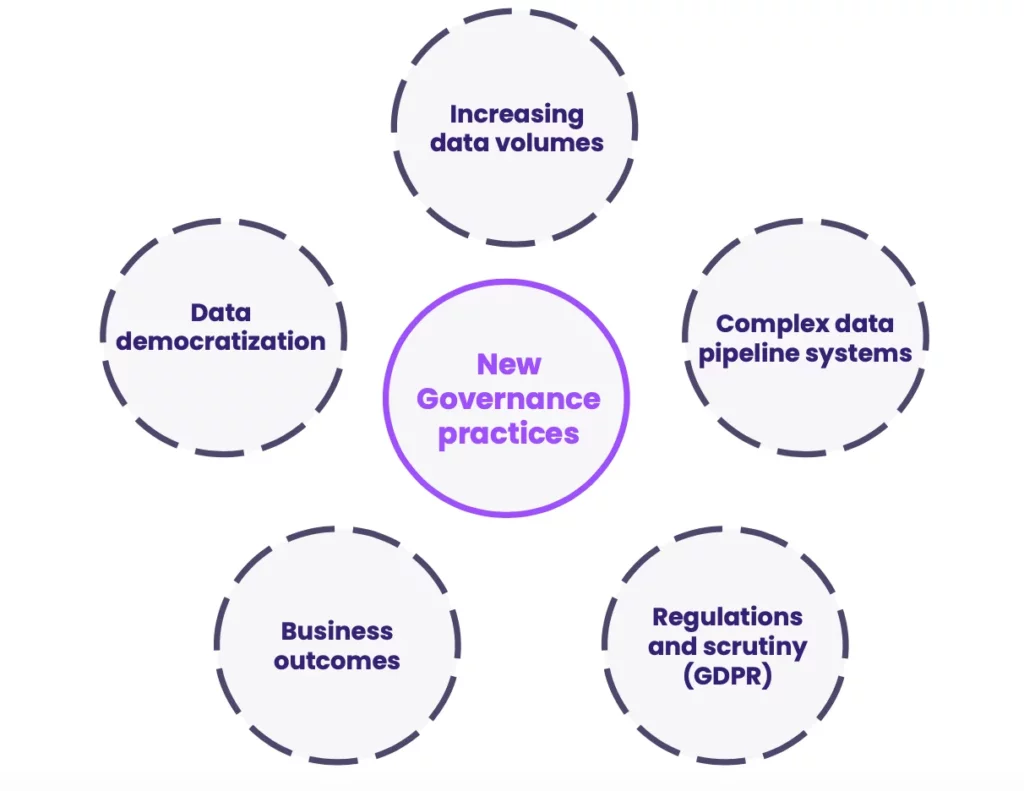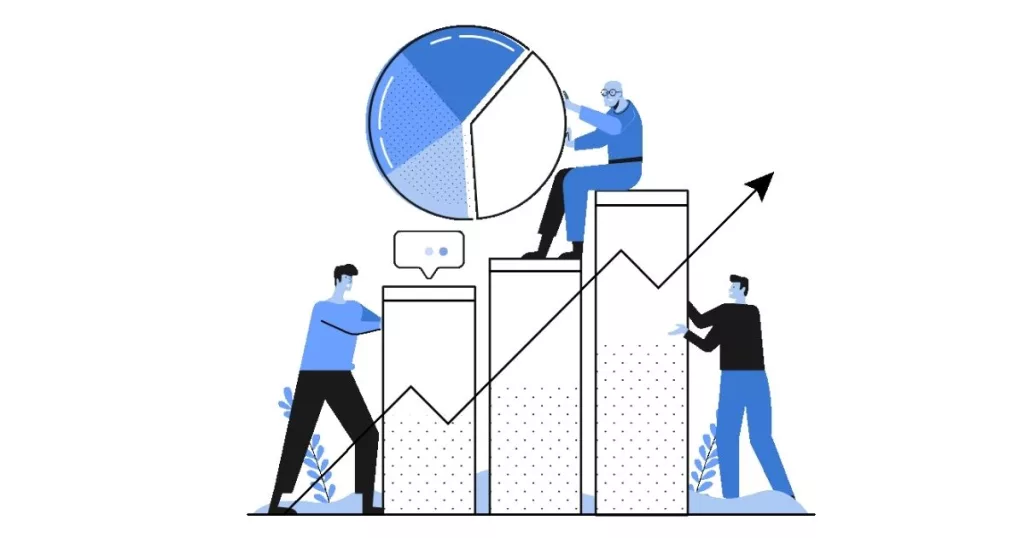Why Data Governance Matters, Best Practices, and How to Build a Strategy

With the rise of GDPR and other compliance measures, data security is under more scrutiny than ever before. Yet as organizations invest in more data and more data accessibility, keeping all that data safe and well-maintained has never been more challenging.
That’s why data governance has become a must-have for data-driven organizations. But despite its importance, many leaders struggle to get a data governance initiative off the ground. Factors like multiple stakeholders with conflicting priorities, poorly defined KPIs, and concerns about “the data police” slowing down the business are all working together to stop data governance programs before they start.
This guide will help you navigate the murky waters of designing and launching a data governance program. We’ll cover exactly what data governance is, how it functions, a few best practices, and a step-by-step guide to building a data governance program that works.
Table of Contents
What is data governance?

First, let’s get on the same page about what data governance actually is—and what it isn’t.
Data governance is the decision-making process organizations use to maintain the availability, usability, and security of data. Good governance programs help organizations “decide how to decide” about data. And as one data leader told us, it’s the “keep your CFO out of jail card.“
Data governance covers a lot of bases, but here are some of the questions it helps organizations answer:
- How is data created, collected, and processed?
- Who should have permission to access this data?
- What data is relevant for each role?
- Where is this data stored?
- When do we retire this data?
One note: Modern data governance looks different than it did in the pre-cloud, on-premises days of data storage and management. Today’s data stack—with its multi-cloud environments, self-serve tooling, remote team access, and distributed frameworks like the data mesh—requires automation and scalability that would have been unthinkable in decades past.
But data governance is not a SaaS solution. Data catalogs are helpful, but they do not equal governance. Rather, data governance is comprised of people, processes, and principles. Data governance requires a governance team (usually including an executive sponsor, a program manager, and hands-on coordinators); a steering committee of business executives and data owners that set the standards for foundational policies; and data stewards that oversee datasets and ensure compliance.
And like most cross-functional initiatives in the workplace, data governance takes a lot of time and effort to design and implement—and a lot of buy-in from all those stakeholders.
Five benefits of data governance
Building a successful governance program requires convincing everyone involved that the investment is worth it. Here are five key benefits of data governance you can use to answer the age-old question, “What’s in it for me?”
1. You’re empowered to make better decisions
That’s right—we’re not putting data security or data privacy or data quality at the top of the list (although those are also benefits of data governance). Instead, let’s look at the end outcome: you can make better business decisions with well-governed data.
That’s because data governance gives analysts, stakeholders, and leaders access to better, more reliable information. And the transparent and collaborative nature of data governance means those stakeholders will have more trust in the data, and more confidence in their decisions.
2. You’ll manage costs and resources more effectively
Data governance, when done right, helps organizations have a clear framework for data access and data quality. Teams can avoid the silos, duplicative data, and one-off requests that eat up resources for data engineering and analytics teams (not to mention software and storage costs).
3. You’ll avoid compliance issues
Over the last several years, as new regulations like GDPR and CCPA have put how companies ingest, store, and share data under a microscope, the appetite for internal access to data has grown by leaps and bounds. And when more data is available for more users—especially through self-serve tooling—the potential risks for compliance issues grow as well.
Data governance helps protect against compliance risks by putting parameters in place around how all users access and use data. Rather than ad-hoc provisioning requests or haphazardly shared datasets, data teams follow prescribed protocols for role-based permissions. And data governance oversight ensures everyone is playing by the rules they agreed to, and following regulations as needed. In other words, the checks and balances of data governance help ensure compliance and regulatory requirements are consistently met.
4. You’ll earn your customers’ trust
When you have strict data governance policies in place, customers’ sensitive information will be better protected, and potential misuse or leaks are less likely to occur. And the data that your customers encounter within your products will be more likely to be accurate. On both sides of the equation—their data is safe and yours is more reliable—customer trust grows.
5. Your risk management will improve
Robust governance keeps data secure. Access controls and monitoring protect your data from threats from outside parties or inappropriate exposure to internal teams, lowering your risk of costly data leaks or other incidents.
As you plan and launch a data governance program, keep these benefits top-of-mind. You’ll want to reference them as you build buy-in on your internal teams.
How to develop a data governance strategy

Data governance looks different at every company, but here are a few basic steps you can take as you build out your governance strategy:
Step 1: Organize your existing data
Data governance policies will be applied to your datasets according to classifications, like whether assets contain personally identifiable information (PII). So your first step is to map and classify your existing data, so you know what you’ll be working with once it comes time to actually govern.
Step 2: Choose a data storage solution
As mentioned above, modern data governance does require some level of automation to make it scalable. Make sure your data storage solution plays well with automation tooling.
Step 3: Prepare your data
Data governance and data observability should work hand-in-hand to ensure your data is accurate, reliable, and trustworthy. Observability provides the visibility you need to see whether data assets or pipelines are broken—so you can troubleshoot issues, solve root causes, and give your governance team a clean slate.
Step 4: Create a data governance model
This is where the magic happens. Building out your data governance model will document the goals and mission statement for your program, its success metrics (more on that below), the decision-making roles and responsibilities, and accountability structures. Every organization will require a custom data governance model tailored to its specific needs and resources, but the Data Governance Institute framework is a good starting point.
Step 5: Review and adapt
Data governance is not a one-and-done. Plan to iterate and improve your data governance program as it gets rolled out to new business areas and encounters new challenges. Evaluate your policies annually, at a minimum—and more frequently if you work in a highly regulated industry like finance or healthcare.
Four data governance best practices
As you work towards building out your basic strategy, keep a few best practices in mind.
Start small: don’t boil the ocean
Data governance programs should apply across the organization—eventually. But when you’re just getting started, it’s best to choose two or three pilot projects. Focus on a few key areas where you can demonstrate impact through governance. Build buy-in and win over advocates through your early initiatives, so you can speak to your track record when tackling tougher areas or more skeptical stakeholders. Plus, starting small gives you a chance to learn from your mistakes.
Know your data governance metrics
There is no one clean and simple metric that will tell you how well your data is being governed. But there are a few ways to go about tracking your success with governance:
Data quality metrics are the most widely used indicators of governance effectiveness. For example, you should see a reduction in the number of data errors and an increase in data completeness and consistency when strong governance processes are in place.
Governance program metrics can also demonstrate the reach of your efforts, such as the number of people who have completed governance training or the number of data sources with a documented governance policy.
Communicate far, wide, and frequently
Data governance is a team sport. It takes buy-in and adoption from every corner of the organization to be successful. But it’s a risky proposition—because without good communication, governance can lead to an “us-versus-them” mentality where data teams are seen as policing their stakeholders.
Instead, build a collaborative model where the benefits of data governance are stated and repeated regularly. And prioritize transparency—everyone should know where the governance model is documented, what its goals are, and what the success metrics say.
Communication can happen through internal channels like Slack or email, and be reinforced by ensuring governance is included in the training for data-related topics (like BI tools or other tech solutions).
Play the long game
It bears repeating: there’s no one-and-done approach to data governance. This is not a project with a start and end date. Governance is a long-term investment that takes an iterative approach. New technologies, new regulations, new products, or new locations could all require an update to your existing governance program. Stay flexible and adaptable, and plan plenty of time for tweaks and adjustments in your governance roadmap.
Getting started with data governance
Interested in implementing a data governance strategy with data trust in mind? Reach out to Brandon and the rest of the Monte Carlo team to learn how data observability can help.
Our promise: we will show you the product.
 Product demo.
Product demo.  What is data observability?
What is data observability?  What is a data mesh--and how not to mesh it up
What is a data mesh--and how not to mesh it up  The ULTIMATE Guide To Data Lineage
The ULTIMATE Guide To Data Lineage 





